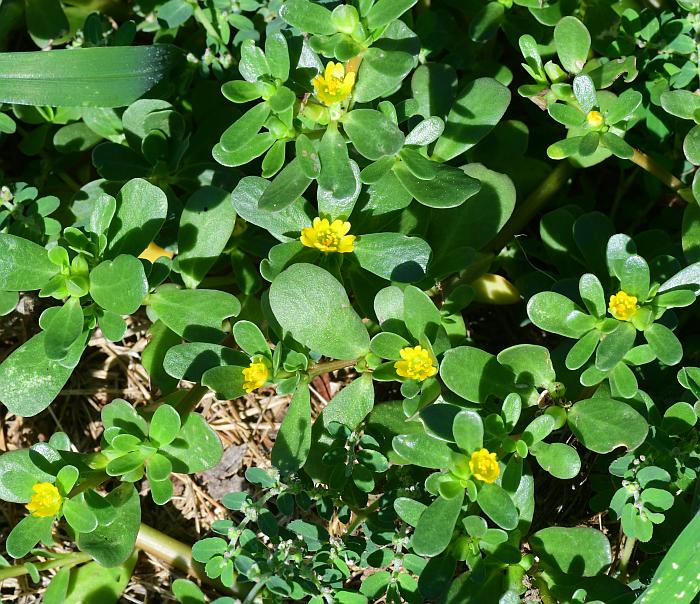Portulaca oleracea L.
Purslane

Native
CC = 0
CW = 3
MOC = 29
© SRTurner
Portulaca oleracea L.Purslane | |
 |
Native CC = 0 CW = 3 MOC = 29 |
© SRTurner |
|
Family - Portulacaceae Habit - Taprooted annual forb with fibrous lateral roots.
Stems - Prostrate, to 50 cm, often red, branching, succulent, glabrous.
Leaves - Alternate, simple, sessile or very short petiolate. Blades 4-30 mm long, 2-15 mm wide, flattened, spatulate to obovate, oblanceolate, or oblong-oblanceolate, succulent, glabrous. Stipules absent (stem nodes glabrous).
Inflorescence - Axillary solitary flowers or small clusters, glabrous or rarely with sparse, inconspicuous, short hairs.
Flowers - Calyx of two overlapping sepals 2.5-4.0 mm long (measured to the base of the ovary). Petals 5, 3-5 mm long, yellow, glabrous. Stamens 6-12. Filaments 1 mm long, translucent yellow, glabrous. Anthers yellow, 0.2-0.3 mm broad. Style 5-lobed, 1.1 mm long, glabrous.
Fruits - Capsules 5-9 mm long, 4-8 mm wide. Seeds 0.6-1.0 mm long, variously orbicular to more or less kidney-shaped, the surface smooth or more commonly appearing roughened or with minute, blunt tubercles, dark brown to black. Placentation free central.
Flowering - June - November. Habitat - Streambanks, pond margins, seeps, bluffs, upland prairies, glades, fields, ditches, gardens, lawns, sidewalks, railroads, roadsides, open disturbed areas. Origin - Uncertain. Lookalikes - None. Other info. - This little plant has been collected in scattered locations in Missouri but is probably more prevalent than records indicate. It is found across the continental U.S. and Canada. It is easily recognized even when vegetative by its prostrate habit and glabrous, succulent herbage. The small yellow flowers are attractive but not often seen. Photographs taken off Prairie View Rd., Platte County, MO., 8-1-00, and in Daytona Beach, FL., 7-2-02 (DETenaglia); also at Matson Hill County Park, St. Charles County, MO, 8-11-2012, in Missouri River floodplain near I-70, St. Louis County, MO 9-28-2017, and near Labadie, Franklin County, MO, 8-25-2020, 9-03-2020, and 7-10-2022 (SRTurner). |